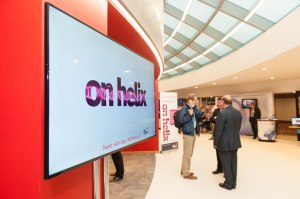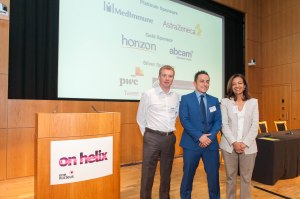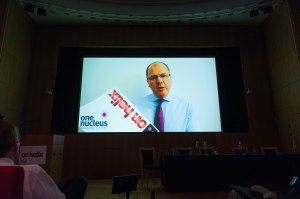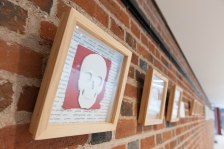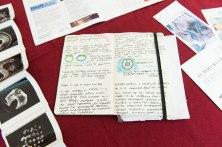This year One Nucleus’ annual Translational Research Conference, ON Helix, moved back to the venue of its inaugural meeting in 2013: the Wellcome Genome Campus, Hinxton, Cambridge, home of both the Sanger Institute and the EMBL-European Bioinformatics Institute (EMBL-EBI). ON Helix was the first conference in its newly re-opened conference centre and the capacity 300 delegates thronging through it on July 14 seemed very pleased with the facilities. There was certainly a buzz throughout the networking sessions.

The scientific programme, too, was truly excellent: varied and stimulating, with a strongly practical focus on the issues involved in translating scientific discoveries into the clinic. A short welcome and introduction by One Nucleus’ CEO, Harriet Fear, led into the first session. The three contrasting keynotes talks had one thing in common: the central importance of the patient’s perspective.
With AstraZeneca’s move to Cambridge setting the seal on the region’s dominant position in UK life sciences, Bahija Jallal, Executive Vice President of AstraZeneca and Head of its biologics division, MedImmune, was an appealing choice for the first keynote speaker. She gave a whistle-stop tour through the changing landscape of drug development, from the old-fashioned ‘one size fits all’ paradigm through today’s stratified medicine to a future possibility of ‘individualised medicine’. Stratified or personalised medicine began in oncology and is still best developed in that discipline, but the paradigm is now applied to many others. Jallal described a monoclonal antibody, sifalimumab, developed by Medimmune to treat lupus and other autoimmune diseases. This drug works very well in 20-25% of patients, but until very recently doctors have been unable to predict who it would benefit in advance. They have now learned that a specific lupus subtype with high levels of the protein interferon is associated with a good response to this drug and are developing this into a diagnostic test. The challenge of ‘individualised’ treatment will be to extend this approach so that, eventually, each patient will be treated with a cocktail of drugs that has been specifically designed to treat his or her particular disease.
Not many patients or relatives are able to make a significant contribution to ‘their’ disease. Parent entrepreneur Nick Sireau, CEO of the AKU Society, gave an inspiring talk describing his journey from his sons’ diagnosis with AKU (alkaptonuria, or black bone disease) to clinical trials of the first drug to have a significant impact on this ultra-rare disease. AKU arises from a defect in one of the proteins in the pathway that metabolises the amino acid tyrosine. The society is supporting clinical trials of nitinisone, a compound that acts in the tyrosine pathway and that, oddly, was first developed as a weed killer. It is already prescribed to treat children with more serious disorders of tyrosine metabolism, but an NIH-sponsored trial in AKU failed to meet its endpoints despite clearly showing that it could help patients. The AKU Society has helped to set up a clinical centre of excellence for the disease in Liverpool and to design and run a unique series of ‘patient-led’ clinical trials. As AKU is extremely rare, the UK community had to work with partners throughout the world to identify enough patients for the trials to be statistically significant. Nick used the term ‘fundamental diseases’ to refer to rare conditions like AKU that can shed light on the mechanisms behind much more common disorders. He helped found Findacure, a charity to support those affected by fundamental diseases, and is a founder member of the Cambridge Rare Disease Network.
The third keynote speaker, Farid Bidgoli from Merck Sharp & Dohme, had a hard act to follow. He filled the slot extremely well with an engaging presentation that used his late grandmother’s life to explain how digital health and health informatics can improve outcomes for patients. In ‘My Nan and her outcomes: what could have been, and what the future could hold for patients’ he told the story of this mother of seven and grandmother of 26 who had, in her 78 years, suffered from breast cancer, obesity, chronic arthritis and COPD. In her last years she had loved her smartphone, so she would probably have become a keen user of some of the health-related apps that are now being developed. While 90% of all NHS consultations still take place face to face, there are enormous opportunities for smoking cessation, lifestyle and rehabilitation services to be delivered on mobile devices. Farid’s Nan would have probably enjoyed using a FitBit style app to track her ability to do gentle exercise, and this might have prevented her becoming bed-bound.
The rest of the talks were arranged into three related sessions based around the general theme of De-Risking innovation in the drug discovery and healthcare industries. Each session included a chair’s introduction, four short talks and an extensive discussion led by the panel of speakers. The first of these, ‘De-Risking Research: Collaborative Models’ was chaired by David Gann from Imperial College, London. The speakers, including Sir Philip Cohen from the University of Dundee whose ground-breaking research into protein phosphorylation and ubiquitinylation is behind the discovery of important cancer drugs, described effective ways of fostering research collaboration between academia and industry and across national boundaries. These include the European Lead Factory, an open platform that gives academics and SMEs full access to ‘Big Pharma’ like facilities for generating and testing new lead molecules.
The second session, chaired by Illumina’s Geoff Smith, took as its theme ‘De-Risking Partnerships: Sharing Data in Collaboration’. Speakers from MISSION Therapeutics, the Babraham Institute, Eli Lilly and the new Centre for Therapeutic Target Validation (CTTV) all stressed the importance of trust between academic and industrial partners, despite their different goals. The CTTV is a partnership between the EMBL-EBI, the Sanger Institute and GSK, established with the aim of selecting and validating ‘druggable’ protein targets using the mountain of openly-accessible data now available to the research community. Interestingly, the theme of open data was returned to by Jenny Laird, the speaker from pharma giant Eli Lilly.
As a scientist and science writer, I was expecting to find the talks in the final session, ‘De-Risking Funding: Investing in Early Stages of Development’ rather hard to understand. I was therefore pleasantly surprised by Eric Karran from Alzheimer’s Research UK, whose inspiring talk about ARUK’s newly established Dementia Research Institutes required no knowledge of finance at all. These are hosted by Oxford and Cambridge universities and UCL in London, described as ‘three of the world’s top five centres of neuroscience research’. This exemplifies the necessary trio of ‘good science, good people and good money’ highlighted by another speaker, Robert Tansley from Cambridge Innovation Capital.
George Freeman MP, so far the world’s only Minister for the Life Sciences, had been booked to give the last talk of all. He was unfortunately unable to attend in person due to a three-line whip at Westminster, but, perhaps appropriately, he gave his short talk by video. He highlighted some ways in which the government aims to support basic and clinical sciences, and industry, as three pillars of translating medicine: a discipline that he described as ‘close to his heart’.
The only small disappointment was something the organisers had no control over: the weather. A cool, cloudy day limited the usually exceptional appeal of the now traditional ice cream van and a few umbrellas made their appearance as we dashed the few metres to the lunch room. Delegates did not, however, need this as an excuse to linger in the centre’s light, spacious new exhibition space. Besides browsing the wide range of exhibitors, they were able to view artwork on the themes of lab work, cells and molecules by a range of artists including MedImmune’s Artist in Residence, who was also ON Helix’s Artist in Residence for the day – Jane Southgate who was there in person to talk about her work.
In closing the meeting, Harriet Fear announced that ON Helix 2016 would he held on 28 June, also at Hinxton. I, for one, have already put this date in my diary.

